- Istituto Nazionale di Geofisica e Vulcanologia, Sezione di Catania, Osservatorio Etneo (INGV-OE), Catania, Italy
The South-East crater of Etna (SEC) is the most active summit crater over the last 20 years, producing lava fountains in 2000, 2007–08, and 2011–14. It has been monitored by the INGV Etna Observatory by instrumental networks, field surveys and petrologic monitoring. The syn-eruptive petrologic monitoring consists of an articulated work chain which is generally carried out within 24 h from the moment the sample was emplaced to detect possible changes of magma composition episode by episode, as well as over a longer period. The findings of petrologic monitoring are integrated with the results provided by geophysical networks and gas geochemistry to check the volcano’s behavior during the eruption and to communicate potentially dangerous variations in eruptive features to the local authorities. This paper presents the variation of volcanic glass compositions during the paroxysmal activity of the SEC, which began in December 2020 and climaxed with 17 episodes from 16 February to 1 April 2021. We infer pre-eruptive magmatic processes (e.g., fractional crystallization and mixing) based on temporal trends of some key compositional parameters (i.e., CaO/Al2O3; FeOtot/MgO). Correlation between magma dynamics and volcanological characteristics of the paroxysms requires future studies. We demonstrated that petrologic monitoring carried out during a volcanic crisis at Etna, as well as in other volcanoes worldwide, may be crucial to acquire preliminary insights into the structure of the plumbing system and the pre-eruptive processes governing the eruptive activity. Interestingly, this goal has been achieved also thanks to the collaboration with local citizens, who kindly contributed to collecting samples.
Introduction
Etna, one of the most active volcanoes in the world, produces various types of eruptions, including both flank and summit eruptions from the four summit craters of the volcano, named Voragine (VOR), Bocca Nuova (BN), North-East (NEC) and South-East (SEC) (Figure 1). The SEC has been the most active crater of the last 20 years, generating periods of effusive activity interspersed with explosive activity of Strombolian type up to lava fountains. In particular, this crater has produced sequences of lava fountain episodes, i.e., the episodic eruptions (Parfitt and Wilson, 1994; Spina et al., 2019) in 2000 (64 episodes, Alparone et al., 2003; Andronico and Corsaro, 2011), 2007-08 (7 episodes, Aiuppa et al., 2010, Andronico et al., 2008, Patanè et al., 2008; Corsaro and Miraglia 2014) and 2011-14 (>50 episodes, Behncke et al., 2014 and references therein). Each episode is characterized by different phases (Alparone et al., 2003) that entail the progressive intensification of Strombolian activity to lava fountains, the formation of a volcanic ash cloud, which can reach tropospheric heights and disperse the fine material even at great distances, and finally the effusion of small lava flows.
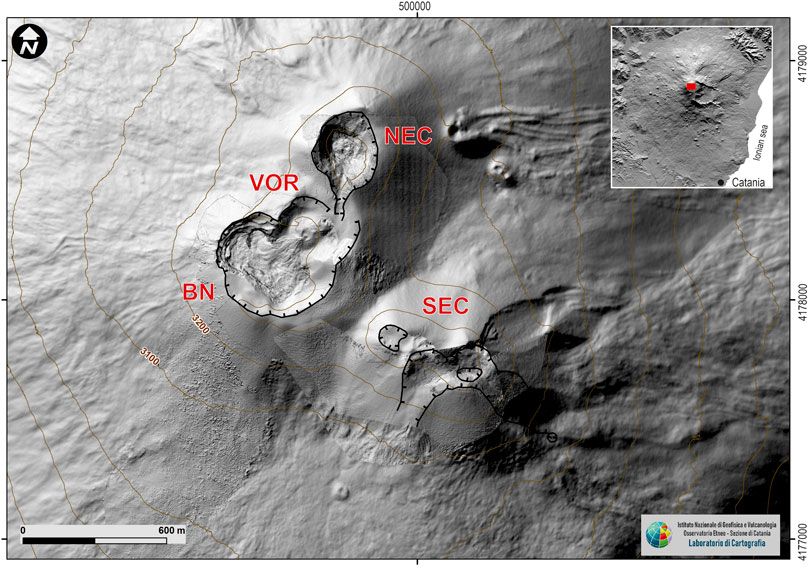
FIGURE 1. Digital elevation model (DEM) of the summit area of Etna modified from the INGV-OE, Bollettino Settimanale sul monitoraggio vulcanico, geochimico e sismico del vulcano Etna, of 06/04/2021. SEC, South-East Crater; VOR, Voragine; BN, Bocca Nuova; NEC, North-East Crater; barbed line indicates the crater rim. The inset in the upper right corner shows the DEM of Etna volcano, where the summit area is indicated with the red box.
In 2021, a new sequence of 17 episodes from the SEC started on 16 February and concluded on 1 April. At the time of writing, a new sequence, which begun on 19 May and continued up to 23 October 2021, has produced 35 new episodes.
The 2021 eruptive activity has been monitored by the Istituto Nazionale di Geofisica e Vulcanologia, Osservatorio Etneo (INGV-OE) that provides scientific support to the operational decisions of the National Civil Protection Department (DPC), and deals with the interpretation of the monitoring data from the instrumental networks, field surveys and laboratory analyses. The petrological monitoring, together with gas geochemistry, is the only activity that provides direct information of the magma’s properties; the findings of petrologic monitoring are integrated with the results provided by geophysical networks and gas geochemistry to check the volcano’s behavior during the eruption and to communicate potentially dangerous variations in eruptive features to the local authorities.
The syn-eruptive petrologic monitoring is essentially aimed at analysing, as quickly as possible, all the useful parameters to detect possible changes of magma composition during an ongoing eruption. To achieve this, we measure the composition of the major elements in the volcanic glass, assuming that it is representative of the pre-eruptive magma composition. This method was successfully applied to study the 2004–05 Etna flank eruption, when samples of effusive activity were quenched with water to inhibit crystallization (Corsaro and Miraglia, 2005); it was also used to investigate the increase of explosive activity from February 2004 at Stromboli (Corsaro et al., 2005), by distinguishing Low Porphyritic (LP) and High Porphyritic (HP) magma (Francalanci et al., 1999; Métrich et al., 2010; Di Stefano et al., 2020; Viccaro et al., 2021).
In this paper, we show the efficiency of petrological monitoring, as described above, to study the paroxysms (i.e., lava fountains) of the SEC, which started in December 2020 and climaxed with 17 episodes from 16 February to 1 April 2021. The temporal trends of the compositional parameters are very detailed because all the paroxysms have been sampled. This sampling strategy allowed us to check the volcano’s behaviour episode by episode, in order to communicate possible variations in eruptive features to the DPC during the eruption. Secondly, the increasingly extended compositional dataset as the eruption proceeded, enabled evaluating changes in the magma composition over a longer period, and to hypothesize the pre-eruptive magmatic processes (e.g., fractional crystallization and mixing) responsible for the observed compositional variations.
The Eruptive Activity of the South-East Crater From 2020 to April 2021
The volcanic activity of the SEC examined in this work covers the interval January 2020- April 2021, in order to acquire a full picture of the phenomena, which preceded the study period (INGV-OE, Bollettini Settimanali sul monitoraggio vulcanico, geochimico e sismico del vulcano Etna, from 07/01/2020 to 06/04/2021 at: https://www.ct.ingv.it/index.php/monitoraggio-e-sorveglianza/prodotti-del-monitoraggio/bollettini-settimanali-multidisciplinari).
During the first quarter of 2020, the SEC produced small and rare ash emissions. The volcanic activity resumed in April with occasional and low intensity Strombolian explosions, which occasionally culminated in more vigorous explosive activity, as occurred on 19 April. In the following months, discontinuous Strombolian explosions of variable intensity continued, producing ash emission lasting for a few hours, and forming ash plumes up to 5 km high above sea level. Starting from December to the end of January 2021, the explosive activity was interspersed with a few paroxysmal episodes, classified by Andronico et al. (2021) as transitional activity, i.e., “strong Strombolian activity alternating with short periods of lava fountains, causing the formation of an eruption plume associated with moderate ash fallout.” They took place on 13, 21 and 22 December 2020 and on 18 January 2021. The paroxysmal activity of the SEC continued in February when, starting from 16 February to 1 April, a sequence of 17 lava fountains took place; more detailed information on this period of activity are in Andronico et al. (2021), Bonaccorso et al. (2021), Calvari et al. (2021), De Gori et al. (2021) and Marchese et al. (2021).
In summary, the volcanic phenomena of the SEC showed increasing intensity throughout 2020, which culminated with the paroxysmal activity of 2021. This pattern was shared, since the end of 2020, with the VOR and BN craters, which produced Strombolian activity of variable intensity and frequent intra-crater lava effusion. We should highlight that, compared with the other craters, SEC activity was the most intense during this period.
Materials and Methods
The syn-eruptive petrologic monitoring at INGV-OE consists of an articulated work chain comprising sample collections, archiving, sample preparation, analyses of glass compositions using SEM-EDS and data interpretation. This work should be carried out within 24 h of the sample emplacement; the operative protocol matches the most common procedures adopted by volcano monitoring institutions worldwide (Re et al., 2021).
We sampled small size lapilli (max = 1 cm) and ash (<2 mm) (Figures 2A,B), because they preserve air-quenched volcanic glass, and are large enough to be rapidly prepared for analysis with SEM-EDS. All the eruptive episodes have been sampled thanks also to local citizens who kindly helped provide material fallen on their properties. This collaboration has ensured that samples have been collected during the fall or soon after deposition on clean surfaces.
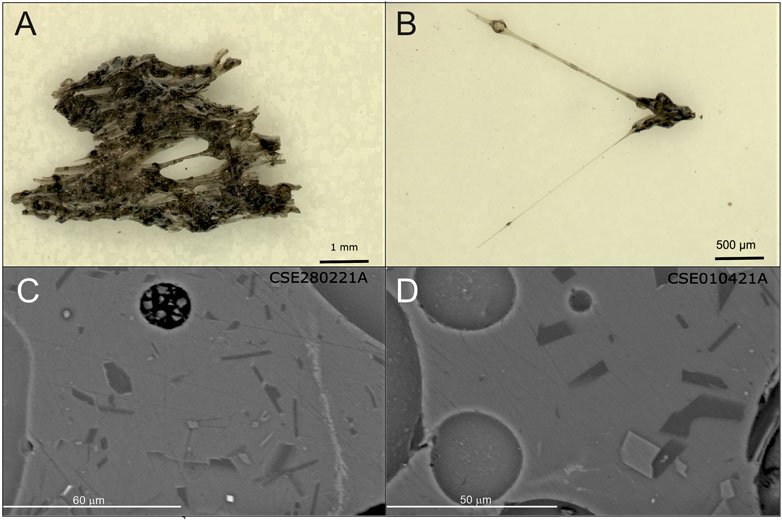
FIGURE 2. Multi focal plane image in polarized reflected light acquired with stereomicroscope of (A) a lapillo and of (B) a clast of ash. BSE image acquired with SEM of groundmass glass (C,D) containing less than 15% microlites.
The glass compositions of major elements have been analysed at INGV-OE with an LEO-1430 scanning electron microscope, equipped with an Oxford EDS micro-analytical system (SEM-EDS). Analytical conditions are 20 keV, 1200 nA beam current and XPP matrix correction method (Pouchou and Pichoir, 1986). In order to minimize alkali loss during analysis, a square raster of 10 microns is used. The accuracy of measurements has been checked through replicate analyses of the international standard VG-2 Glass basaltic, USNM 111240/52 (Jarosewich et al., 1980). The precision, expressed as relative standard deviation, is less than 1% for SiO2, Al2O3, FeO, MgO and CaO and less than 3% for TiO2, MnO, Na2O, K2O and P2O5 (Miraglia, 2012). The analyses have been performed in groundmass glass containing less than 15% microlites (Figures 2C,D). Each value is the average of 10–15 analyses (Tables 1–3, Miraglia, 2021c and Miraglia, 2021d).
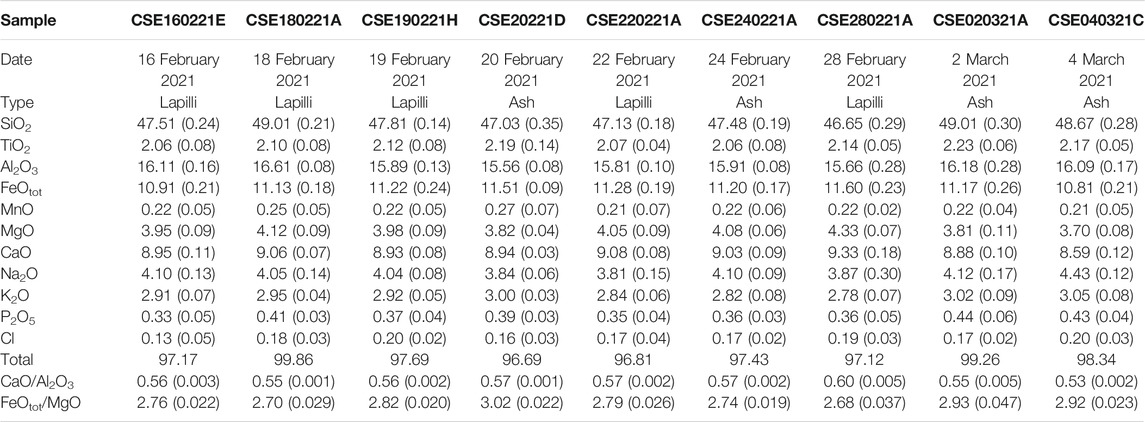
TABLE 1. Selected average (±σ) glass compositions of the SEC products erupted from 16 February to 4 March 2021.
Results
The major element compositions of volcanic glass have been measured in lapilli and ash erupted by the SEC during all 17 paroxysms of February–April 2021, of 13, 21 December 2020 and of 18 January 2021 (Tables 1–3). Data have been plotted in a CaO/Al2O3 vs. FeOtot/MgO diagram (Figure 3) where, following Corsaro and Pompilio (2004), the main compositional trend (see grey arrow in Figure 3) results from the crystallization of plagioclase, clinopyroxene and olivine) at shallow depth. In other words, plotting analyses of samples on this diagram can be used to qualitatively evaluate if magma composition becomes more or less primitive through time. Other variation diagrams (Figure 4) complement the analysis of the compositional variation of the analyzed products.
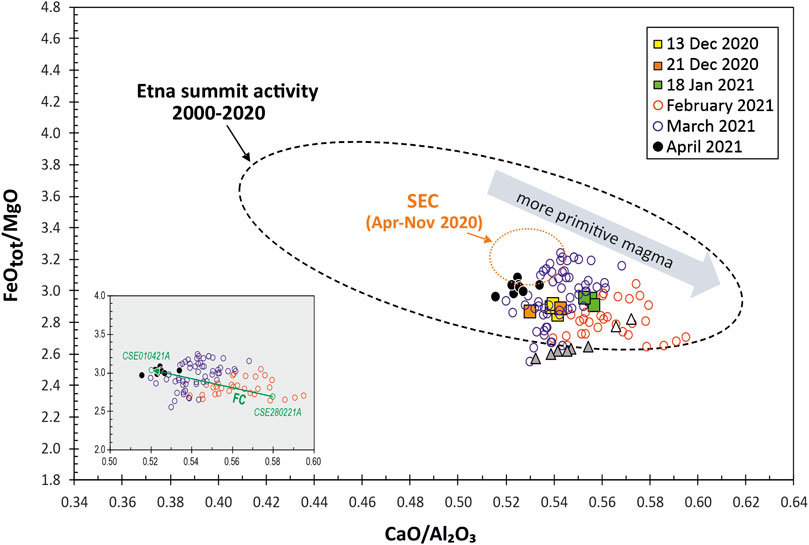
FIGURE 3. CaO/Al2O3 vs. FeOtot/MgO in glass of the SEC products erupted during the paroxysmal activity of December 2020, January 2021 and the sequence of February–April 2021. The glass compositional fields of the SEC in April–November 2020 (orange dotted circle) and of the Etna summit activity in 2000–20 (black dashed line), are also plotted. The compositions of glasses emitted during the SEC paroxysmal activity of 15–17 May 2000 (grey triangle) and 23 November 2013 (open triangles) are also plotted for comparison (Corsaro and Miraglia, 2021). The grey arrow indicates more primitive magma compositions according to Corsaro and Pompilio (2004). In the inset, the fractional crystallization process from the most primitive composition of February (sample CSE280221A) to one of the most evolved of April (sample CSE010421A) is depicted by the green arrow (FC).
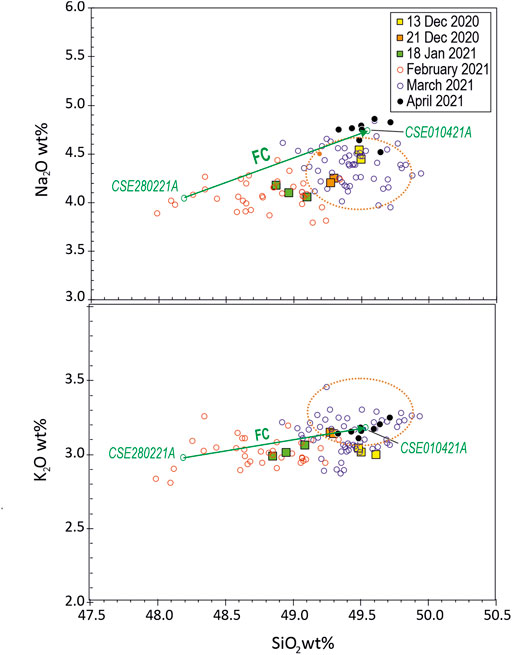
FIGURE 4. SiO2 vs. Na2O and K2O in glass of the SEC products erupted during the paroxysmal activity of December 2020, January 2021 and the sequence of February–April 2021. The glass compositional field of the SEC in April–November 2020 (orange dotted circle) is also plotted for comparison. The analyses are recalculated to 100 wt%. The description of the fractional crystallization trend (FC) as in Figure 3.
Taking into account the activity of the SEC preceding the 17 lava fountains of 2021, it is interesting to note that (Figures 3–5): 1) the Strombolian activity of Apr–November 2020 produces a rather evolved magma compared to the other studied products; 2) the lava fountain of 13 December 2020 marks the eruption of a more primitive magma than before; 3) the trend toward more primitive composition continues during the 21 December 2020 and 18 January 2021 lava fountains.
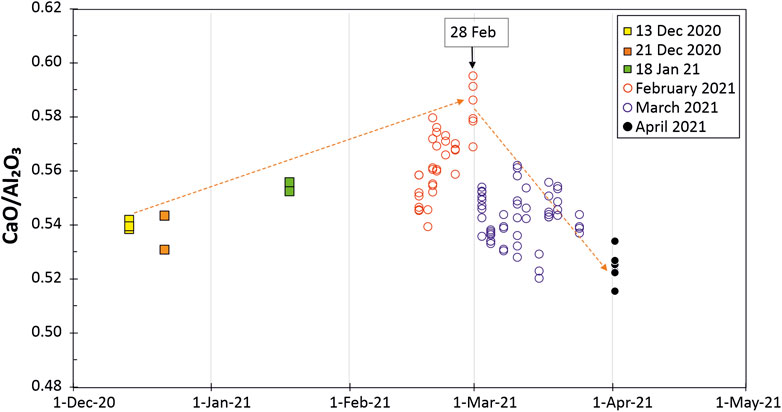
FIGURE 5. Temporal variation of CaO/Al2O3 in glass of the SEC products erupted during the paroxysmal activity of December 2020, January 2021 and the sequence of February-April 2021. The ascending arrow from December 2020 to the end of February 2021 highlights a magma becoming more primitive, suggesting that a gradual intrusion of a new deep magma into the SEC reservoir started from December 2020 and climaxed in February 2021. On the contrary, the descending arrow from March to the last paroxysm of 1 April 2021 indicates an increasing magma evolution owing to fractional crystallization.
Over the following sequence of 17 lava fountains, data reveal that (Figures 3–5): 1) the paroxysms of February 2021 (from 16 to 28) are sustained by an even more primitive magma (Table 1, CaO/Al2O3 = 0.55–0.60, FeOtot/MgO = 2.68–3.02; SiO2 = 46.65–49.01, Na2O = 3.81–4.10, K2O = 2.78–3.00) than 18 January (Table 3, CaO/Al2O3 = 0.56, FeOtot/MgO = 2.90, SiO2 = 48.14, Na2O = 4.1, K2O = 2.94). In particular, on 28 February, one of the most primitive magma of the SEC in the last 20 years was erupted (Figure 5), similar (Figure 3) to the paroxysms of 15–17 May 2000 and 23 November 2013 (Miraglia, 2021a; Miraglia, 2021b); 2) magma of the March lava fountains (from 2 to 24) is more evolved (Tables 1, 2, CaO/Al2O3 = 0.52–0.56, FeOtot/MgO = 2.74–3.19, SiO2 = 47.65–49.73, Na2O = 4.12–4.58, K2O = 2.97–3.16) than February; 3) the last fountain of 1 April produces one of the most evolved magmas (Table 2, CaO/Al2O3 = 0.52, FeOtot/MgO = 2.98, SiO2 = 49.36, Na2O = 4.76, K2O = 3.15) of the sequence, which partly overlaps the compositional field of the April–November 2020 products.
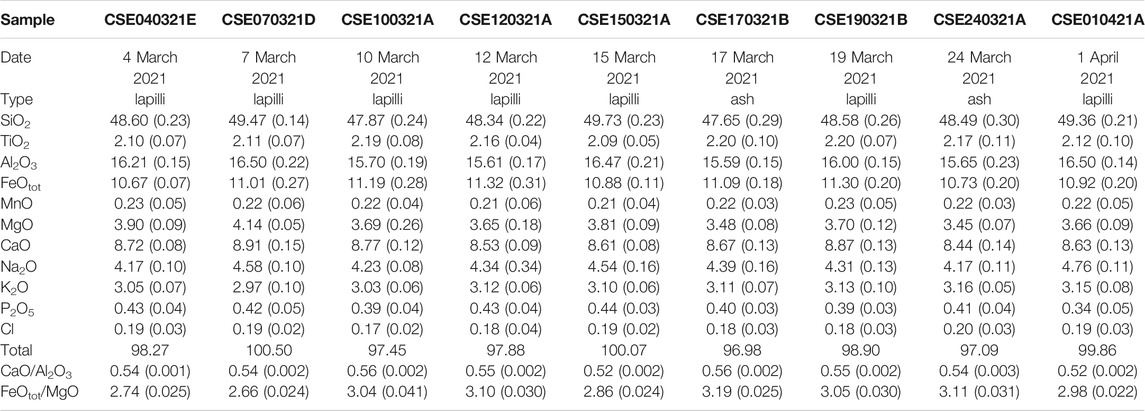
TABLE 2. Selected average (±σ) glass compositions of the SEC products erupted from 4 March to 1 April 2021.
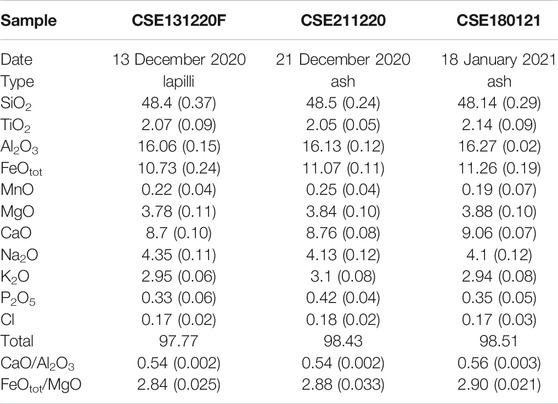
TABLE 3. Selected average (±σ) glass compositions of the SEC products erupted during the paroxysms of December 2020 and January 2021.
In synthesis, the glass compositions suggest that the paroxysmal activity of the SEC, which started on 13 December 2020, is sustained by an increasing more primitive magma until 28 February, when an inversion occurs. Indeed, magma of the following paroxysms gradually became more evolved, finally going back to the pre-paroxysms compositions of April–November 2020.
Discussion
In order to explain the long-term compositional variability of magma erupted by the SEC described above, we have put forward preliminary hypotheses. Firstly, that the eruption of a more primitive magma, which started in December 2020 and peaked in February 2021, was due to a significant recharge of deeper and more primitive magma in the SEC reservoir, where a 2020 pre-paroxysms magma was stored; the refilling presumably started at the end of 2020 and continued up to the first period (February) of the 2021 paroxysmal activity. Secondly, that the inversion toward more evolved magma composition after February is due to a less efficient transfer of deep magma into the SEC reservoir; this condition enhanced the progressive cooling and crystallization of the stored magma, which gradually evolved and returned to compositions of the 2020 pre-paroxysms period (April–November 2020). We will discuss the first and second point respectively in Mixing and Fractional Crystallization.
Mixing
The significant recharge of a deeper and more primitive magma in the SEC reservoir, from December 2020 to February 2021 has been modelled assuming that the slightly evolved 2020 pre-paroxysms magma stored in the SEC reservoir until November mixed with a deeper and more primitive magma that progressively intruded it.
The primitive intruding magma has been chosen according to the petrologic studies of the 2001 and 2002–03 flank eruptions of Etna. Indeed, Métrich et al., 2004 and Spilliaert et al. (2006a) found that the primitive melt inclusions hosted in olivine were trapped under total fluid pressure ranging from 400 to 200 MPa. In particular, Spilliaert et al. (2006a) suggested that the primitive basaltic and trachybasaltic magma containing the olivines, ascended from ponding zones located respectively at ≥ 10 km and 6-4 km b.s.l. This background allowed modelling two mixing curves (Langmuir et al., 1978) between the evolved end-member EV (Figure 6, i.e., the most evolved glass of the 2020 pre-paroxysms period, erupted by the SEC in November 2020–sample CSE051120-ash, Miraglia, 2021c) and two possible primitive end-members (Figure 6): PR1 (i.e., the composition of the 5–41b melt inclusion, hosted in olivine with Fo = 81.5, trapped at 400 MPa, see Table 2 of Spilliaert et al., 2006a) and PR2 (i.e., the composition of the 5–30b melt inclusion hosted in olivine with Fo = 81.8, trapped at 230 MPa, see Table 2 of Spilliaert et al., 2006a). Therefore, PR1 and PR2 represent possible magmas stored respectively at ≥ 10 km and 6-4 km b.s.l, which intruded the SEC reservoir and mixed with the EV magma stored there.

FIGURE 6. CaO/Al2O3 vs. FeOtot/MgO (average values) in glass of the SEC products erupted during the paroxysmal activity from 13 December 2020 to 28 February 2021 (see the dates in the legend). Mixing curves have been modelled between EV, sample CSE051120-ash (Miraglia, 2021c), and respectively: i) PR1 (sample 5–41b of Spilliaert et al., 2006a) and ii) PR2 (sample 5–30b Spilliaert et al., 2006b). Ticks on the mixing lines are the percentage (in grey) of the PR1 or PR2 end-members in the mixed magma. See text for details.
Most of our data plot along the two modelled mixing curves (Figure 6). In particular, during the paroxysmal activity of 13, 21 December 2020 and 18 January 2021, the erupted magma is the result of a mixing process between EV magma and about 15% of a primitive end-member (poles PM1-PM2). The more primitive magma erupted later, during the paroxysmal activity of February 2021, suggests the involvement of more extended proportions of the PM1-PM2 end-members, up to about 30%.
Therefore, on the basis of our compositional modelling, it may be suggested that, up to November 2020, a EV magma resident in the SEC shallow reservoir had fed the Strombolian activity of the crater (Figure 7A). In a period ranging from November to the first half of December 2020, a new magma ascending from a deep zone of the plumbing system (10–5 km b.s.l.) started to intrude the SEC shallow reservoir, where it began to mix with the resident magma. The resulting mixed magma (about 15% of the primitive component in the resident magma) was erupted during the 13, 21 December 2020 and 18 January 2021 paroxysms. Magma transfer from deep zones to the SEC reservoir continued, so that the paroxysmal activity of February 2021 was sustained by an even more primitive magma (up to about 30% of the primitive component in the resident magma) (Figure 7B).
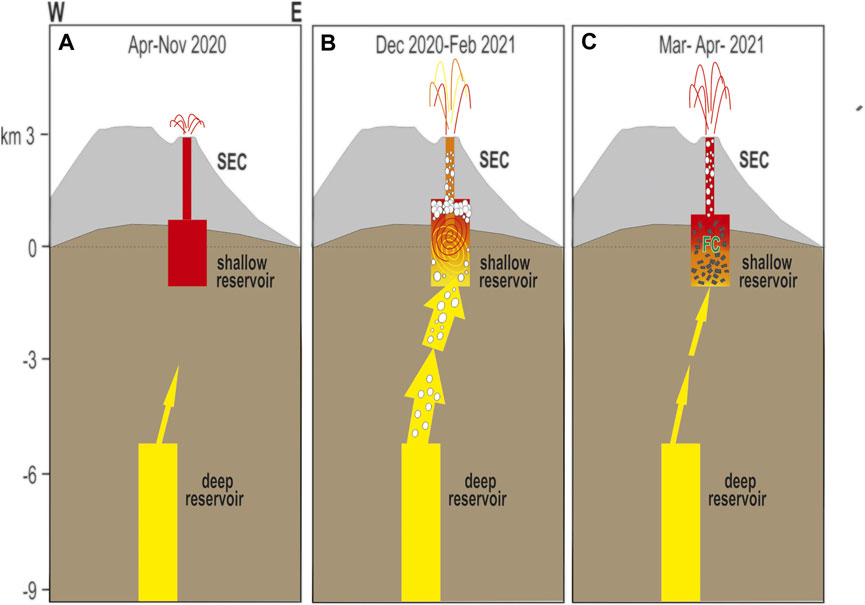
FIGURE 7. Cartoon illustrating magma dynamics of Etna plumbing system driving the paroxysmal activity of December 2020—April 2021. (A) in April-November 2020 the magma stored in the shallow SEC reservoir feeds the explosive activity of the SEC; (B) from December 2020 to the end of February 2021 an increasing more primitive magma is erupted, which is the result of a mixing between the magma stored in the SEC reservoir and a new magma ascending from a deep zone of the plumbing system. (C) in March-April 2021 the paroxysmal activity is fed by a more evolved magma owing to fractional crystallization (FC). See the text for details.
Mixing between distinct magmas is a well-known process to interpret the compositional variability of the products erupted during the paroxysmal activity of the SEC in 2000 (Andronico and Corsaro, 2011) and 2007–08 (Corsaro and Miraglia, 2014). Indeed, the temporal variation of bulk rock compositions can be explained by a mixing between an evolved magma stored in the SEC reservoir and a new more primitive magma, which intrudes it. Petrologic data (Spilliaert et al., 2006b) set the top of the SEC reservoir at about 1.5 km below the crater, i.e., at the base of the volcanic pile. This position is confirmed by a recent seismic tomography study of Etna (De Gori et al., 2021), which showed two small shallow reservoirs at about 1 km b.s.l. that feed the activity of the summit crater, similar to the 2021 paroxysms; also the strain variations constrain the position of the source that fed the 2021 paroxysmal sequence in the range depth 0.5–1 km b.s.l. (Bonaccorso et al., 2021).
As discussed above, the compositional variations of the erupted products have allowed us to infer that a gradual intrusion of a new deep magma into the SEC reservoir started from December 2020 and climaxed in February 2021. Interestingly, this hypothesis is supported by other monitoring data. Indeed, the reappraisal of volcanic activity is associated with an increase of seismic release started in December 2020, when deep (>12 km) and shallow (<3 km) clusters of earthquakes occurred contemporaneously (De Gori et al., 2021); for the authors, seismic signals have been produced by almost contemporaneous melt injections within magmatic reservoirs at deep and shallow depths. More in detail, the tensile source modeling of the strain recorded by the borehole dilatometer (Bonaccorso et al., 2021) has suggested that the shallow seismic swarm of 19 December 2020 has testified to the migration of fresh magma to a shallow level of the plumbing system.
Fractional Crystallization
The turnaround of glass toward more evolved compositions starting from March to April 2021 has been modelled assuming that the magma stored in the SEC at the end of February evolved owing to fractional crystallization (FC).
To this end, mass balance calculations with XLFRAC (Stormer and Nicholls, 1978) have been performed choosing: the most primitive composition of 28 February glass (sample CSE280221A, average CaO/Al2O = 0.58 and FeOtot/MgO = 2.70, SiO2 = 48.19 wt%, Na2O = 4.06 wt%, K2O = 2.98 wt%) as parental magma, and one of the most evolved composition of 1 April glass (sample CSE010421A, average CaO/Al2O3 = 0.52 and FeOtot/MgO = 3.02, SiO2 = 49.52 wt%, Na2O = 4.74 wt%, K2O = 3.17 wt%) as residual magma (Figures 3, 4). Fractionating minerals are set to include the most common phases that crystallize at shallow conditions since their removal produces a liquid line of descent described by Corsaro and Pompilio (2004), that matches the compositional trend depicted by our samples starting from the end of February. For this model, we use the most primitive compositions of the microphenocrysts present in the parental magma of 28 February 2021, i.e., plagioclase (An = 85), olivine (Fo = 81), clinopyroxene (Wo = 47, En = 39, Fs = 14), and Ti-magnetite (Usp = 36). The results show that the compositional variability of the products erupted from the end of February to April 2021 is well explained by a fractional crystallization process (Figures 3, 4) that involved the magma stored in SEC reservoir in that period (Figure 7C). Indeed, the removal of 12% crystals consisting of 4% plagioclase, 1% olivine, 5% clinopyroxene, and 2% Ti-magnetite, provides a good fit (sum of the residuals = 0.08) between measured and modelled compositions.
Conclusive Remarks
The petrological monitoring of the paroxysmal activity, which began in December 2020 and culminated with the sequence of 17 episodes from 16 February to 1 April 2021, has enabled us to track the evolution of magma composition, taking into account all the eruptive episodes for the first time at Etna. This goal has been achieved also thanks to the collaboration developed with local citizens, who kindly contributed to collecting samples.
Volcanic glass compositions become progressively more primitive from December 2020 up to the end of February 2021; the trend is later inverted and magma becomes gradually more evolved up to the end of the sequence on 1 April 2021. These compositional features can be explained by increasing degrees of mixing between the magma residing in the shallow SEC reservoir and a new recharging magma ascending from a deep region of the plumbing system (10–5 km b.s.l.); the mixing produced a progressively more primitive magma erupted up to the end of February. When the efficiency of the deep magma transfers and/or of the mixing process decreased, the effect of cooling and crystallization prevailed and the magma present in the SEC reservoir evolved due to fractional crystallization involving about 12% vol. of minerals.
In this framework, the role played by petrologic monitoring during an eruption is of primary importance to acquire preliminary insights into the structure of the plumbing system and the pre-eruptive processes governing the eruptive activity at Etna and other volcanoes worldwide. A stimulating perspective to address in the future would be to understand how magma dynamics affect the volcanological features and the timing of the periodic lava fountains at Etna.
Finally, petrologic monitoring can give an important contribution to the volcanic hazard assessment of active volcanoes. Indeed, its findings can provide information of possible eruptive styles and magnitude of activity, according to the recommendations of Pallister et al. (2019).
Data Availability Statement
The original contributions presented in the study are included in the article/Supplementary Material, further inquiries can be directed to the corresponding author.
Author Contributions
RC Conceptualization, Formal Analysis, Writing-Original Draft, Visualization LM Conceptualization, Formal Analysis, Investigation, Visualization
Conflict of Interest
The authors declare that the research was conducted in the absence of any commercial or financial relationships that could be construed as a potential conflict of interest.
Publisher’s Note
All claims expressed in this article are solely those of the authors and do not necessarily represent those of their affiliated organizations, or those of the publisher, the editors and the reviewers. Any product that may be evaluated in this article, or claim that may be made by its manufacturer, is not guaranteed or endorsed by the publisher.
Acknowledgments
Our warm thanks to INGV colleagues who contributed to collecting samples. Sampling has greatly benefited from the kind collaboration of the local citizens: G. Aidala, S. Barbagallo, L. Cammarata, E. Finocchiaro, R. Meli and D. Pennisi. Our thanks go to S. Conway for revising the English language. We are also grateful to the Italian Civil Protection Department (DPC) for the financial support given to the petrologic monitoring of INGV-OE. This research was carried out in the frame of the IMPACT PROJECT (INGV Department strategic Projects–2019) WP1, Task 3-Dynamics of magmatic processes.
References
Aiuppa, A., Cannata, A., Cannavò, F., Di Grazia, G., Ferrari, F., Giudice, G., et al. (2010). Patterns in the Recent 2007-2008 Activity of Mount Etna Volcano Investigated by Integrated Geophysical and Geochemical Observations. Geochem. Geophys. Geosyst. 11, Q09008. doi:10.1029/2010GC003168
Alparone, S., Andronico, D., Lodato, L., and Sgroi, T. (2003). Relationship between Tremor and Volcanic Activity during the Southeast Crater Eruption on Mount Etna in Early 2000. J. Geophys. Res. 108, B52241. doi:10.1029/2002JB001866
Andronico, D., Cannata, A., Di Grazia, G., and Ferrari, F. (2021). The 1986-2021 Paroxysmal Episodes at the summit Craters of Mt. Etna: Insights into Volcano Dynamics and hazard. Earth-Science Rev. 220, 103686. doi:10.1016/j.earscirev.2021.103686
Andronico, D., and Corsaro, R. A. (2011). Lava Fountains during the Episodic Eruption of South-East Crater (Mt. Etna), 2000: Insights into Magma-Gas Dynamics within the Shallow Volcano Plumbing System. Bull. Volcanol. 73 (9), 1165–1178. doi:10.1007/s00445-011-0467-y
Andronico, D., Cristaldi, A., and Scollo, S. (2008). The 4-5 September 2007 Lava fountain at South-East Crater of Mt Etna, Italy. J. Volcanology Geothermal Res. 173, 325–328. doi:10.1016/j.jvolgeores.2008.02.004
Behncke, B., Branca, S., Corsaro, R. A., De Beni, E., Miraglia, L., Proietti, C., et al. (2014). The 2011-2012 summit Activity of Mount Etna: Birth, Growth and Products of the New SE Crater. J. Volcanology Geothermal Res. 270, 10–21. doi:10.1016/j.jvolgeores.2013.11.012
Bonaccorso, A., Carleo, L., Currenti, G., and Sicali, A. (2021). Magma Migration at Shallower Levels and Lava Fountains Sequence as Revealed by Borehole Dilatometers on Etna Volcano. Front. Earth Sci. 9, 740505. doi:10.3389/feart.2021.740505
Calvari, S., Bonaccorso, A., and Ganci, G. (2021). Anatomy of a Paroxysmal Lava Fountain at Etna Volcano: The Case of the 12 March 2021, Episode. Remote Sensing 13, 3052. doi:10.3390/rs13153052
Corsaro, R. A., and Miraglia, L. (2021). Lapilli e ceneri: Il magma primitivo dell’Etna non ha segreti. Blog INGVvulcani. Rome: INGV. Available at: : https://ingvvulcani.com/2021/02/22/lapilli-e-ceneri-il-magma-primitivo-delletna-non-ha-segreti.
Corsaro, R. A., and Miraglia, L. (2005). Dynamics of 2004-2005 Mt. Etna Effusive Eruption as Inferred from Petrologic Monitoring. Geophys. Res. Lett. 32, L13302. doi:10.1029/2005GL022347
Corsaro, R. A., and Miraglia, L. (2014). The Transition from summit to Flank Activity at Mt. Etna, Sicily (Italy): Inferences from the Petrology of Products Erupted in 2007-2009. J. Volcanology Geothermal Res. 275, 51–60. doi:10.1016/j.jvolgeores.2014.02.009
Corsaro, R. A., Miraglia, L., and Zanon, V. (2005). Petrologic Monitoring of Glasses in the Pyroclastites Erupted in February 2004 by the Stromboli Volcano, Aeolian Islands, Southern Italy. J. Volcanology Geothermal Res. 139, 339–343. doi:10.1016/j.jvolgeores.2004.08.002
Corsaro, R. A., and Pompilio, M. (2004). Magma Dynamics in the Shallow Plumbing System of Mt. Etna as Recorded by Compositional Variations in Volcanics of Recent summit Activity (1995-1999). J. Volcanology Geothermal Res. 137 (1-3), 55–71. doi:10.1016/j.jvolgeores.2004.05.008
De Gori, P., Giampiccolo, E., Cocina, O., Branca, S., Doglioni, C., and Chiarabba, C. (2021). Re-pressurized Magma at Mt. Etna, Italy, May Feed Eruptions for Years. Commun. Earth Environ. 2, 216. doi:10.1038/s43247-021-00282-9
Di Stefano, F., Mollo, S., Ubide, T., Petrone, C. M., Caulfield, J., Scarlato, P., et al. (2020). Mush Cannibalism and Disruption Recorded by Clinopyroxene Phenocrysts at Stromboli Volcano: New Insights from Recent 2003-2017 Activity. Lithos 360-361, 105440. doi:10.1016/j.lithos.2020.105440
Francalanci, L., Tommasini, S., Conticelli, S., and Davies, G. R. (1999). Sr Isotope Evidence for Short Magma Residence Time for the 20th century Activity at Stromboli Volcano, Italy. Earth Planet. Sci. Lett. 167, 61–69. doi:10.1016/s0012-821x(99)00013-8
Jarosewich, E., Nelen, J. A., and Norberg, J. A. (1980). Reference Samples for Electron Microprobe Analysis*. Geostand. Newslett. 4 (1), 43–47. doi:10.1111/j.1751-908x.1980.tb00273.x
Langmuir, C. H., Vocke, R. D., Hanson, G. N., and Hart, S. R. (1978). A General Mixing Equation with Applications to Icelandic Basalts. Earth Planet. Sci. Lett. 37, 380–392. doi:10.1016/0012-821x(78)90053-5
Marchese, F., Filizzola, C., Lacava, T., Falconieri, A., Faruolo, M., Genzano, N., et al. (2021). Mt. Etna Paroxysms of February-April 2021 Monitored and Quantified through a Multi-Platform Satellite Observing System. Remote Sensing 13, 3074. doi:10.3390/rs13163074
Métrich, N., Allard, P., Spilliaert, N., Andronico, D., and Burton, M. (2004). 2001 Flank Eruption of the Alkali- and Volatile-Rich Primitive basalt Responsible for Mount Etna's Evolution in the Last Three Decades. Earth Planet. Sci. Lett. 228, 1–17. doi:10.1016/j.epsl.2004.09.036
Métrich, N., Bertagnini, A., and Di Muro, A. (2010). Conditions of Magma Storage, Degassing and Ascent at Stromboli: New Insights into the Volcano Plumbing System with Inferences on the Eruptive Dynamics. J. Petrol. 51 (3), 603–626. doi:10.1093/petrology/egp083
Miraglia, L. (2012). Caratteristiche del sistema analitico SEM-EDS: valutazione dell'accuratezza e della precisione delle analisi eseguite su standards internazionali di minerali e vetri. Rome: Rapporti tecnici INGV, 233.
Miraglia, L. (2021a). Etna Glass Analyses 2000 (GMCET_2000). Rome: INGV Repository. doi:10.13127/etna/gmc_2000
Miraglia, L. (2021b). Etna Glass Analyses 2013 (GMCET_2013). Rome: INGV Repository. doi:10.13127/etna/gmc_2013
Miraglia, L. (2021c). Etna Glass Analyses 2020 (GMCET_2020). Rome: INGV Repository. doi:10.13127/etna/gmc_2020
Miraglia, L. (2021d). Etna Glass Analyses January-April 2021 (GMCET_JA2021). Rome: INGV Repository. doi:10.13127/etna/gmc_jan_apr2021
Pallister, J., Papale, P., Eichelberger, J., Newhall, C., Mandeville, C., Nakada, S., et al. (2019). Volcano Observatory Best Practices (VOBP) Workshops - a Summary of Findings and Best-Practice Recommendations. J. Appl. Volcanol. 8, 2. doi:10.1186/s13617-019-0082-8
Parfitt, E. A., and Wilson, L. (1994). The 1983-86 Pu'u 'O'o Eruption of Kilauea Volcano, Hawaii: a Study of dike Geometry and Eruption Mechanisms for a Long-Lived Eruption. J. Volcanology Geothermal Res. 59, 179–205. doi:10.1016/0377-0273(94)90090-6
Patanè, D., Di Grazia, G., Cannata, A., Montalto, P., and Boschi, E. (2008). Shallow Magma Pathway Geometry at Mt. Etna Volcano. Geochem. Geophys. Geosyst. 9, 1–13. doi:10.1029/2008GC002131
Pouchou, J. L., and Pichoir, F. (1986). Les éléments très légers en microanalyse X. Possibilités des modèles récents de quantification. J. de microscopie de spectroscopie électroniques 11 (4), 229–250.
Re, G., Corsaro, R. A., D'Oriano, C., and Pompilio, M. (2021). Petrological Monitoring of Active Volcanoes: A Review of Existing Procedures to Achieve Best Practices and Operative Protocols during Eruptions. J. Volcanology Geothermal Res. 419, 107365. doi:10.1016/j.jvolgeores.2021.107365
Spilliaert, N., Allard, P., Métrich, N., and Sobolev, A. V. (2006a). Melt Inclusion Record of the Conditions of Ascent, Degassing, and Extrusion of Volatile-Rich Alkali basalt during the Powerful 2002 Flank Eruption of Mount Etna (Italy). J. Geophys. Res. 111, B04203. doi:10.1029/2005JB003934
Spilliaert, N., Metrich, N., and Allard, P. (2006b). S-Cl-F Degassing Pattern of Water-Rich Alkali basalt: Modelling and Relationship with Eruption Styles on Mount Etna Volcano. Earth Planet. Sci. Lett. 248, 772–786. doi:10.1016/j.epsl.2006.06.031
Spina, L., Cannata, A., Morgavi, D., and Perugini, D. (2019). Degassing Behaviour at Basaltic Volcanoes: New Insights from Experimental Investigations of Different Conduit Geometry and Magma Viscosity. Earth-Science Rev. 192, 317–336. doi:10.1016/j.earscirev.2019.03.010
Stormer, J. C., and Nicholls, J. (1978). XLFRAC: a Program for the Interactive Testing of Magmatic Differentiation Models. Comput. Geosciences 4, 143–159. doi:10.1016/0098-3004(78)90083-3
Keywords: Etna summit eruptions, lava fountains, petrologic monitoring, glass compositions, mixing, fractional crystallization
Citation: Corsaro RA and Miraglia L (2022) Near Real-Time Petrologic Monitoring on Volcanic Glass to Infer Magmatic Processes During the February–April 2021 Paroxysms of the South-East Crater, Etna. Front. Earth Sci. 10:828026. doi: 10.3389/feart.2022.828026
Received: 02 December 2021; Accepted: 02 February 2022;
Published: 25 February 2022.
Edited by:
Pablo Samaniego, UMR6524 Laboratoire Magmas et Volcans (LMV), FranceReviewed by:
Daniele Morgavi, University of Perugia, ItalyHeather Michelle Wright, United States Geological Survey (USGS), United States
Copyright © 2022 Corsaro and Miraglia. This is an open-access article distributed under the terms of the Creative Commons Attribution License (CC BY). The use, distribution or reproduction in other forums is permitted, provided the original author(s) and the copyright owner(s) are credited and that the original publication in this journal is cited, in accordance with accepted academic practice. No use, distribution or reproduction is permitted which does not comply with these terms.
*Correspondence: Rosa Anna Corsaro, cm9zYW5uYS5jb3JzYXJvQGluZ3YuaXQ=
 Rosa Anna Corsaro
Rosa Anna Corsaro Lucia Miraglia
Lucia Miraglia